iPad 4 (Late 2012) Review
by Anand Lal Shimpi on December 6, 2012 4:40 PM ESTCPU Performance
Like the A6, the 4th generation iPad's A6X integrates two custom designed Apple Swift CPU cores that implement the ARMv7 instruction set. The two cores share a 1MB L2 cache, just like they do in the iPhone 5's A6. I spent a lot of time characterizing the architecture and performance of Swift in our iPhone 5 review, so I won't go over a lot of that here. What I will say is that Swift manages to be the best balance of performance and power efficiency in an ARM based CPU core available today. Swift looks a lot like Apple's take on Qualcomm's Krait core. It's not a Cortex A15 competitor from a performance standpoint, but likely a more power efficient design.
Unlike what we saw in the previous iPads, the A6X only boasts a marginal increase in max clock speed (~7%) over the A6. The two Swift cores can run at up to 1.4GHz in the A6X compared to 1.3GHz in the A6.
| Apple iPhone/iPad CPU Clock Comparison | |||||
| iPhone | iPad | iPad Frequency Advantage | |||
| Apple A4 Generation | 800MHz | 1.0GHz | 25% | ||
| Apple A5 Generation | 800MHz | 1.0GHz | 25% | ||
| Apple A6 Generation | 1.3GHz | 1.4GHz | 7.7% | ||
CPU performance improves substantially over the 3rd generation iPad thanks to the Swift cores. Unfortunately, big gains in CPU performance aren't always apparent in actual use. The iPhone 5 seemed to subjectively gain more from the move to A6, partially because of just how frequency constrained the A5 in the 4S was. The A5X CPUs in the iPad 3 were already running 25% faster than the A5's CPU cores.
I didn't notice appreciable differences in application launch times, but there are a few areas were the faster CPU cores definitely stand out. Auto enhance in iPhoto completes quicker on the iPad 4 vs. its predecessor. This is especially true for work on large (high MP) images. I don't think a pair of Swift cores is all it takes to make the iPad 4 a suitable photo retouching workstation but it's better than the previous model.
| General Use CPU Performance Comparison | |||||
| iPad 2/mini | iPad 3 | iPad 4 | |||
| iPhoto Auto Enhance 36MP JPG | 11.7 seconds | 12.0 seconds | 9.1 seconds | ||
| Batman: The Dark Knight Rises Level Load Time | 36.3 seconds | 35.9 seconds | 31.1 seconds | ||
Scrolling around iOS Maps in 3D view is substantially smoother on the 4th gen iPad compared to its predecessor. We noticed something similar in our comparison of the iPhone 5 and 4S. Web pages do load quicker on the iPad 4, although the differences can be small depending on the complexity of the page in question. The real world responsiveness benefit from the faster CPU cores seems to be in the 10 - 30% range depending on what you're doing. The problem is at the lower end of the scale, it can be difficult to really feel if you're comparing the 3rd and 4th gen iPads.
We're still very limited in good, cross-platform CPU benchmarks. We, once again, turn to JavaScript tests run in the browser. For all of the tablets tested here we're using Chrome for Android and Mobile Safari for iOS.
SunSpider has been a part of all of our mobile performance testing for quite a while now. It's not the perfect benchmark, but the test ends up being a good measure of browser performance as well as cache latency and CPU performance.
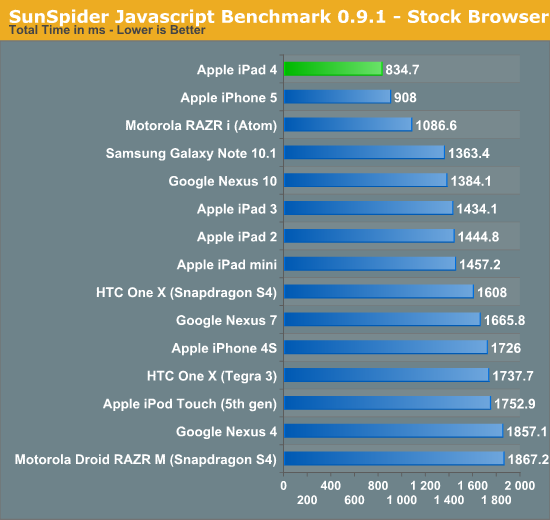
The Swift cores do an excellent job here thanks to their much improved memory performance. The Nexus 10 should be competitive however the current state of browser optimizations hold it back a bit here.
Google's Octane benchmark is a much larger test than SunSpider, but we're still looking at JavaScript performance. Octane includes all 8 of the tests from Google's older V8 benchmark but adds 5 new ones including a PDF reader, 3D bullet physics engine and portable 3D game console emulator all built in javascript.
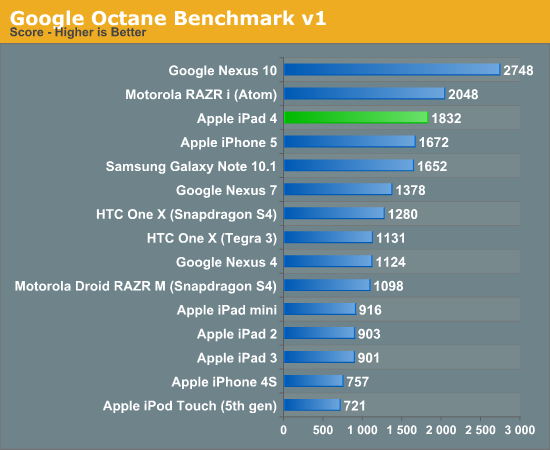
Octane tells a very different story. The iPad 4 does very well, but the Nexus 10's Cortex A15s are really allowed to shine here. The A15 is simply in a different league of performance.
Finally we have Kraken, a seriously heavy javascript benchmark built by Mozilla. Kraken focuses on forward looking applications that are potentially too slow to run in modern browsers today. The result is much longer run times than anything we've seen thus far, and a very CPU heavy benchmark:
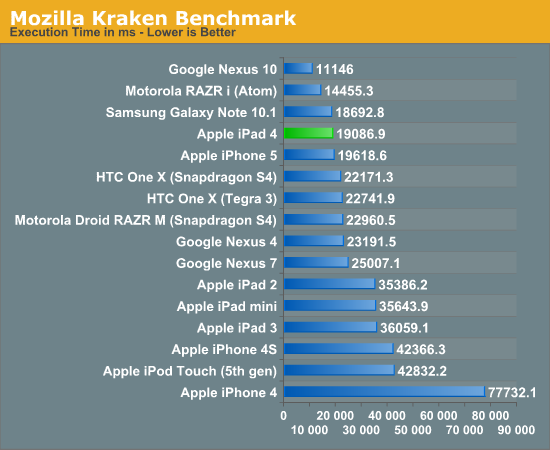
We see a similar story with Kraken. Apple improved CPU performance tremendously over the iPad 3, but the Nexus 10 is able to reach new heights.
Why don't we see a direct correlation between these CPU bound js tests and the real world performance numbers I mentioned above? The problem is that most of today's iOS apps are really built for the sort of performance that a pair of Cortex A9s can deliver. I see pockets of CPU bound activity but it's not consistent enough where you're going to necessarily see a dramatic improvement in responsiveness across the board. I do believe the gap is more apparent on the iPhone thanks to the huge difference in frequency between the 4S and 5, but on the iPad the range from subtle to noticeable differences is broader.
Memory Bandwidth
A look at Chipworks' die shot reveals the same memory interface arrangement as we saw in the A5X:
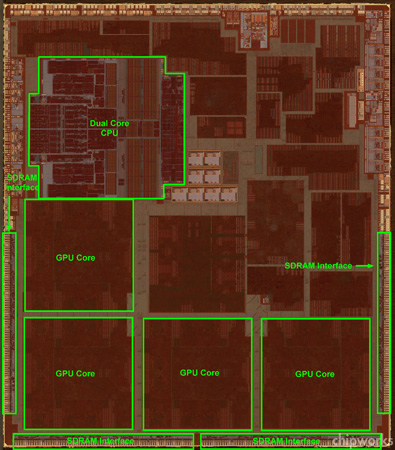
Apple A6X die via Chipworks
The A5X/A6X place the memory interface blocks (and perhaps the controllers themselves?) adjacent to the GPU, while the A5/A6 more tightly integrate the CPU and memory controller. This highlights a pretty substantial difference in priority between the A5/A6 and A5X/A6X SoCs. The latter really do prioritize memory bandwidth delivery to the GPU, and for good reason. The Retina Display equipped iPads have over 4x the number of pixels as the iPhone 5.
The 4th generation iPad that iFixit took apart had 1GB of Hynix LPDDR2-1066 on-board, which would indicate a small increase in memory bandwidth. Just as we saw with the A5/A5X comparison, the additional memory bandwidth doesn't appear to be available to the CPU cores - only the GPU cores.


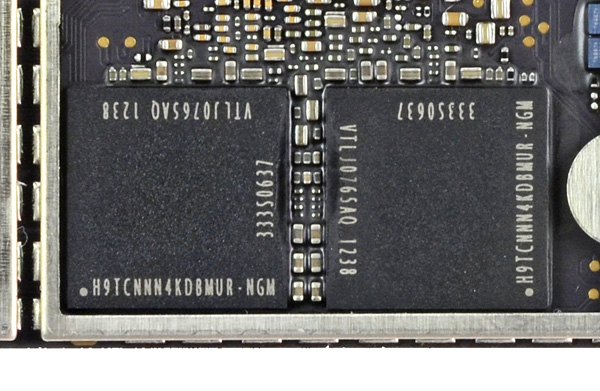
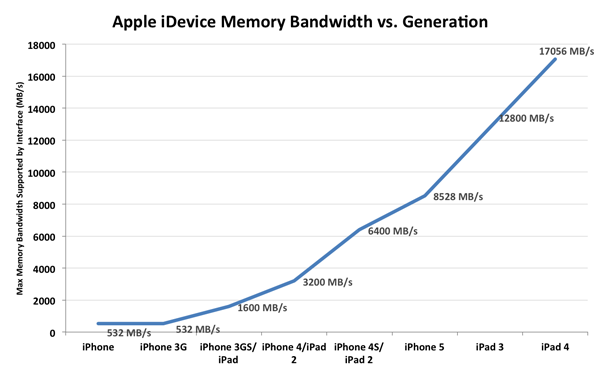








113 Comments
View All Comments
darkcrayon - Friday, December 7, 2012 - link
"Can you run full OS VMs in iOS? "Well iOS is perfectly capable of running emulators if that's what you mean. I start up Windows 3.1 on mine every once in a while for a laugh ;)
If you mean run at some metal-level virtualization then no, but then that wouldn't really be running on Android so much as on the hardware of the device.
antef - Friday, December 7, 2012 - link
If you think Android is just as appliance-like as iOS then I feel there are major things about the platform that you are uninformed about. Not saying that in a demeaning way, just saying perhaps you never discovered these aspects of the system.iOS cannot be considered a true "computing platform" when you can only get apps via the App Store, they can only do what Apple approves of, and they can't truly run in the background, instead being able to only do certain things when not in the foreground. It's a large set of restrictions limiting what can be done with the device, thus it's an appliance, regardless of what functionality apps may or may not provide. It's no different from a set-top box or any other CE device, except it offers way more apps.
Android, on the other hand, even without rooting or messing with custom ROMs, lets you install any app, from any source, that does anything the developer wishes it to do. You don't have to use any app store or pay Google any fees if you don't want to. Apps can touch almost any part of the system or replace any part of the system. Apps can do absolutely anything in the background with almost no restriction. You can browse and manage files like on a PC. The list goes on and on.
Same thing regarding customization. Without rooting Android, you can change its keyboard, default browser, default mail handler, and the entirely of its home screen (icons, dock, app drawer, all can be replaced with alternate launcher).
Android has very few restrictions above and beyond what a typical desktop platform like Windows has. It's essentially Linux with a special app container format and custom UI, that ships without su by default. Yeah, maybe the typical user just using web, texting, and Facebook will think both platforms are equally appliance-like, but that doesn't change the fact of what Android can do. I believe Anand's analysis is spot on.
darkcrayon - Friday, December 7, 2012 - link
It seems Android can only do "certain things" in the background as well. Or maybe you can tell me how to play youtube audio from the browser while Chrome is suspended (You can do this in Safari on iOS).iOS is a true computing platform - it's your definition of "computing" that is the problem. You *can* enter code and run software on it that did not originate on the App Store (not that if you couldn't, it would somehow cease to be a "computing platform".)
It's certainly easier to do more "mucking around" with Android - iOS just has a more security oriented approach while Android has more versatility. Of course for 99% of users for either platform, none of that matters in the slightest as they buy the device to browse the web, play media, and find useful software to run.
Velius - Monday, December 10, 2012 - link
First, I have to thank everyone who responded to my original post. I was shaking my head afterward submitting my post since the way it was originally written was definitely flamebait. Kudos for being respectful and *helpful* in your responses, when I most certainly deserved an ass-kicking.These are all good points (especially antef with respect to my original points) and well expressed. You are right, there are more things that can be customized in Android, but I think you can do it in iOS too - just have to jailbreak it first. The difference, IMO, is that with Android, you *have* to replace most of the defaults because the defaults are really not good. When I used my SGS3, the default keyboard was horrendously slow. SwiftKey 3 rectified that to a large extent, but was a paid app. Why should I have to pay to have a usable keyboard?
Same with the music player - I disagree, first of all, that Poweramp is better than the iOS music player. I found Poweramp to be underwhelming, with player buttons and icons that look like really badly designed bitmaps. Along these lines, any music player on Android lacks the fine-grained seek capabilities that iOS has (which is called "scrubbing" there). I really missed the ability to seek with greater or lesser granularity, going down to the second. You can't do that in Android - the seeks are all giant leaps. Similar story with volume control. There are only 15 settings on the SGS3 (and I assume Android in general). Most of the time, the music I would listen to would be ideally loud between, say, 12 and 13, but I could never set it to that. If I set the volume to 12, it would be too soft, and if I set it to 13, too loud. In iOS, there is very fine control over volume. And let's not even get to transitions between tracks. There is always a gap in the default SGS3 music player between tracks - this would perhaps have been understandable in 1995, but is completely unacceptable today!
These little things add up substantially - the list goes on and on - making iOS just more polished. Even the basic OS responsiveness is a deal-breaker. On my SGS3, if I reboot the phone and go to type something up, say in a text message, it takes about 10 seconds before it even registers my keyboard presses. This is mind-boggling, and I truly wonder how many people on online forums say Android is "faster" - it is not, at least definitely not with the OS interface. I really do believe that people who claim Android is faster just haven't used iOS. Once you do, you just can't go back. :3
Getting back to the original topic, I also don't fully agree that iOS is an appliance. The reason Apple vets software before allowing it to go on the App Store is mostly for quality control. Just search Google for "android apps insecure", and read pages with titles like, "Research says Android users at high risk of installing insecure apps", "Researchers find 1,000 insecure Android apps", and "One in five Android apps is insecure". Yes, you can sideload apps onto your Android phone, but it's a double-edged sword: the Android software ecosystem is a true wild west, with all the attendant issues: buggy or plain crappy software, crashes, malware, insecure apps, etc. I'm not saying Apple's App Store is immune to this, but it's definitely far less prone to it.
In all, I stand by my original claim: "iOS is an appliance, Android is a true computing experience" is a completely bogus and harmful meme. Why harmful? Because millions of people are buying Android phones in the belief that it's better than iOS, when it just isn't. They are thus robbing themselves of a truly polished, wonderfully designed mobile hardware+software computing platform (iOS on iPhone) that is still the top in its class.
Peace.
Velius - Monday, December 10, 2012 - link
Just to clarify, the point I made about Android's responsiveness - and examples I gave from my experience - were all based on Jelly Bean 4.1 stock ROM from Samsung. The "project butter" benefits were only really seen when scrolling between pages (and even then, it got choppy as the SGS3 was loading some widgets). Otherwise, when you open a browser or basically any app, and try to scroll, it is noticeably less smooth. It's like it only scrolls in jumps of 20 pixels at a time. Reducing animation times and forcing GPU rendering in the options alleviated this somewhat, but not entirely.Again, it boggles the mind how such a powerful device (from the hardware standpoint) can be so slow in its user interface - arguably the most important factor in usability!
DeciusStrabo - Friday, December 7, 2012 - link
for its power, the App selection, the looks, the lightning connector (yes, except the price it's really a great connector), Airplay etc.However, I don't like it nearly as much holding it in my hands than my Nexus 10. It's cold, slippery, heavy. You can't really hold it in one hand easily and if you use your body to prop it up if you lie on your couch the edge tends to get really uncomfortable (less than with the iPad 2 but still far too much). As nice as the aluminium looks I prefer the cheaper looking coated plastic of the Nexus 10. Also, speakers on the front > speakers on the back, usually where you tend to hold the thing, even if the one on the iPad is better than the two on the Nexus soundwise.
maximumGPU - Friday, December 7, 2012 - link
what's more concerning is how exactly do you have use for 2 same sized tablets?!eallan - Friday, December 7, 2012 - link
Sometimes we like to waste money on toys!seapeople - Friday, December 7, 2012 - link
2 people = use for 2 tablets? Perhaps the guy is married? Otherwise, I agree, he's insane. It would be like the most colossal waste of money on the planet to buy multiple tablets within a five year period. I mean, that's like half a thousand dollars... for each! Only a very select few fat cats in our society make thousands of dollars that they can just spend on stuff.mavere - Saturday, December 8, 2012 - link
I honestly can't decide whether the latter half of your post is sarcasm.